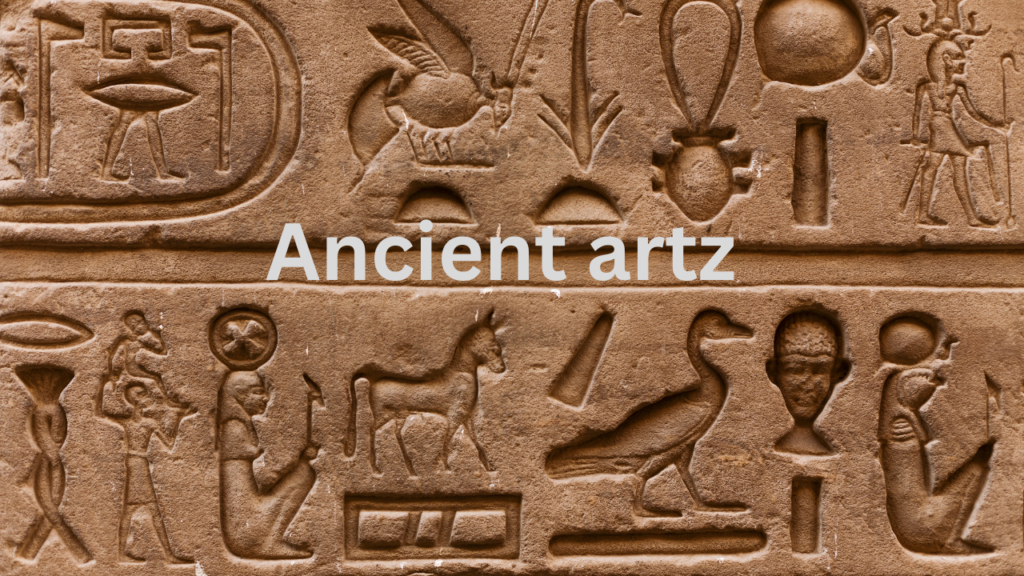Ancient artz work is a portal to the beyond, offering useful insight into the lives, beliefs, and imagination of early civilizations. It’s an art form that existed before written words, depositing the content of mortal culture via oils, puppets, and architectural masterpieces. This article delves into the beginnings, meaning, styles, and lasting legacy of ancient art in various parts of the globe.
The Beginnings and Development of Ancient Artz
Ancient artz work has a history relationship lower back to neolithic periods, whilst early human beings crafted basic delineations on delve partitions. Some of the most prominent known examples are the delve oils of Altamira, Spain, and Lascaux, France, which can be over 17,000 instances antique. These oils confirmed animals, searching scenes, and symbolic numbers, offering a glimpse into the lives and beliefs of the early human .Today, ancient art continues to inspire home decor, bringing timeless beauty and cultural heritage into modern living spaces.
As civilizations developed, art became more sophisticated and played a central role in liars, religious deification, and social scale. The shift from gemstone busts to complex puppets and massive structures reflected the increasing complexity of ancient societies.
The Impact of Early Artistic Expressions on Society
Historic Masterpieces wasn’t merely decorative; it played crucial artistic and functional roles
- Religious Symbolism many Antique Art works were designed to identify gods and illustrate sacred narratives.
- Political Power emperors and lords employed grand architectural workshops to reflect their influence and power.
- Literal Attestation Art preserved events, traditions, and societal values for future generations.
- Aesthetic Beauty Pursuit of harmony, balance, and proportion was the core of many cultural traditions.
Great Societies Known for Their Artistic Legacy
Egyptian Art A legacy of eternity
Egyptian art is one of the most easily identifiable types of ancient cultural representation. It was closely linked with religion and the afterlife, as evidenced by conglomerations, tabernacles, and ornate grave oils. key characteristics of Egyptian art are
- Hieroglyphics and Symbolism Used to narrate stories and worship deities.
- Stiff and Stylized Forms numbers are often represented in profiles with swollen proportions.
- Grand Monuments Conglomerations, tabernacles, and statues such as the Sphinx and the colossal statues of Ramses II.
Greek Art The Birth of Classical Ideals
Greek art transformed form, crockery, and armature to focus on literalism, balance, and beauty. The Greeks refined sculptural ways, such as in marble statues of gods, athletes, and proponents. Key features include
- Idealized mortal Forms delineations of the perfect constitution in puppets such as the Venus de Milo and Discobolus.
- Architectural sensations The Parthenon and other impressive tabernacles stressed proportion and harmony.
- Hellenistic Expressionism latterly Greek art brought more emotion and movement in puppets.
Roman Art Literalism and majesty
Roman art built on top of Greek influences but focused more on literalism and engineering prowess. Their contributions are
- naturalistic pictures Busts and statues of emperors and significant numbers.
- Mosaics and Oils Highly detailed wall oils showing diurnal life and tradition.
- Architectural Masterpieces The Colosseum, Pantheon, and courses displayed superior engineering skills.
Chinese Painting gospel and Harmony
Ancient Chinese painting depicts profound affinities towards nature, gospel, and church. Some important benefactions are
- Calligraphy and Essay oils focused on geographies, poetry, and philosophical ideas.
- Citation Ceramics and Crockery Elaborately crafted vessels of the Shang and Zhou Dynasties.
- Terracotta Army Thousands of life-sized dog faces buried along with Emperor Qin Shi Huang.
Mesoamerican Painting tradition and Astronomy
The prehistoric cultures of Mesoamerica, such as the Maya, Aztecs, and Olmecs, created complex works of art narrated by religious myth and cosmic knowledge. Their cultural contributions are
- Massive Stone Puppets The Olmec colossal heads are a mystery in regards to their function and craftsman.
- Aggregate tabernacles Chichen Itza was one of the structures that acted as traditional and astronomical hubs.
- Tempera oils Illustrated gods, ceremonies, and significant literary events.
Legacy of Early Artistic Traditions
Historic Masterpieces have had a lasting influence on ultramodern cultural forms, armature, and artistic identity. Many modern cultural movements, from the Renaissance to Neoclassicism, borrowed alleviation from ancient cultural principles. moment, museums across the globe preserve and display these masterpieces, enabling unborn generations to learn and enjoy them.
Why Ancient Art Matters moment
Historic Masterpieces is more than a literal artifact; it continues to mold the world in vibrant ways
- Alleviation for ultramodern Artists rudiments of ancient ways influence modern art and design.
- Cultural Heritage Preservation sweats to cover ancient artworks assist in keeping literal stories alive.
- Technological Advancements in Restoration Digital technology and 3D imaging assist in reconstructing and interpreting lost artworks.
Conclusion
Ancient art is a timelessness witness to human imagination, artistic creativity, and outright deceiver. From Egypt’s symbolic hieroglyphs to China’s philosophical essay oils, these cultural works remain to entice and inform individuals across the globe. The legacy of Antique Art is a foundation linking the past to the present, yet reminding us of human participating cultural heritage and its immense impact on civilization.


